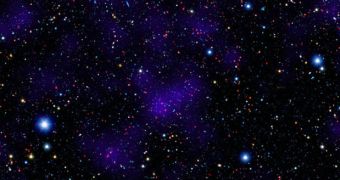By combining the infrared capabilities of the NASA Spitzer Space Telescope with the shorter-wavelength infrared and visible ones from the Subaru Telescope, in Hawaii, astronomers recently managed to obtain an amazing view of a distant cluster of galaxies.
The large cosmic structures appear only as tiny red dots in the new view, which combines infrared and visible-light observations in a comprehensive view of this corner of the Universe. However, experts were surprised to see the massive number of galaxies that lurked in this field of view.
What puzzled astronomers even further was the fact that the galactic cluster they saw contained old, red, and massive galaxies. In space, this is the equivalent of finding modern skyscrapers while digging for Mesopotamian ziggurats.
The ancient cluster CLG J02182-05102 contains galaxies that are very modern in appearance. Theories state that such types of galaxies shouldn't theoretically exist in the early Universe, especially as far away as this cluster was found.
“We are seeing something already aged and red like a younger version of the Coma Cluster from a distant, bygone era,” explains the lead author of the new study, expert Casey Papovich.
“It is as though we dug an archaeological site in Rome and found pieces of modern Rome in amongst the ruins,” adds the expert, who holds an appointment as an assistant professor of physics and astronomy at the Texas A&M University in College Station.
What's also worthy of mention here is the fact that this distant cluster was very large, in the sense that it contained numerous galaxies. In fact, it contained more than some of today's modern clusters do.
The reason why this is significant is because the latter had a few extra billion years at their disposal to develop, whereas ClG J02182-05102 existed very early on in the history of the Universe.
Standard models – widely accepted by the international astronomical community today – indicate that the Cosmos is about 13.75 billion years old, having formed following an event known as the Big Bang.
For the first 300 million years, there was nothing in the Universe worthy of mention, until the first star appeared. About 200 million years later, the first galaxies were already there as well.
The new study joins a growing body of evidence showing that something else happened during the Universe's early history. As telescopes get better, astronomers are beginning to see galaxies that were very modern in appearance, but which existed alongside primordial-looking ones, Daily Galaxy reports.

 14 DAY TRIAL //
14 DAY TRIAL //